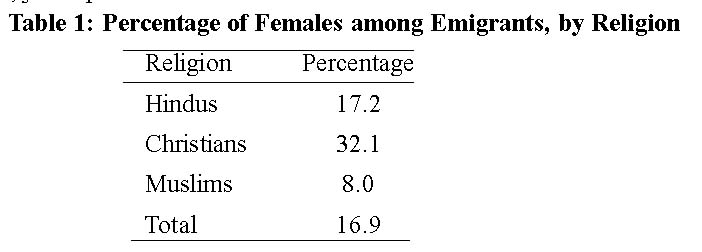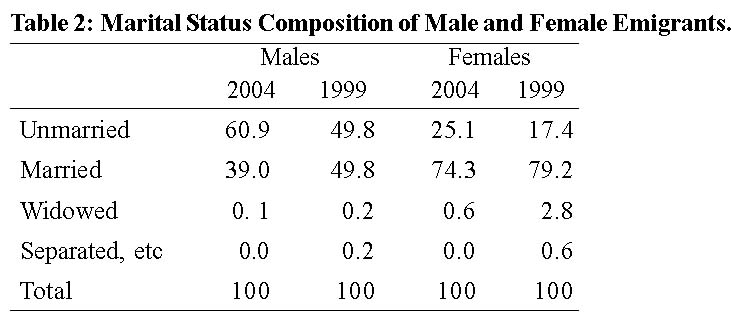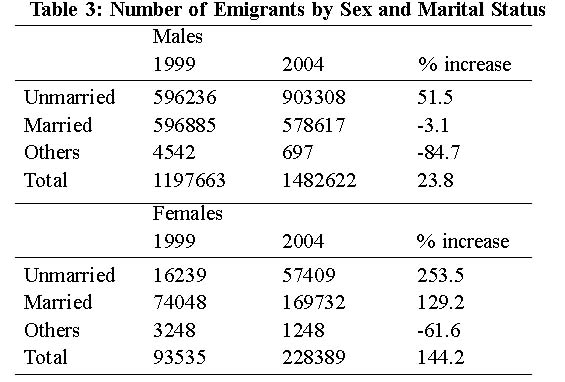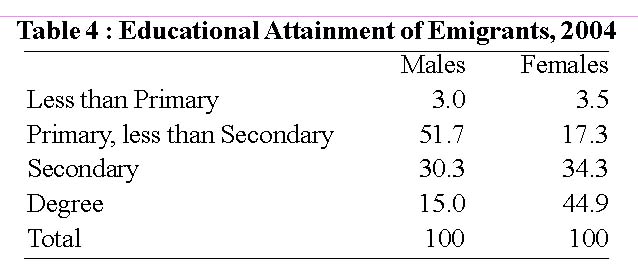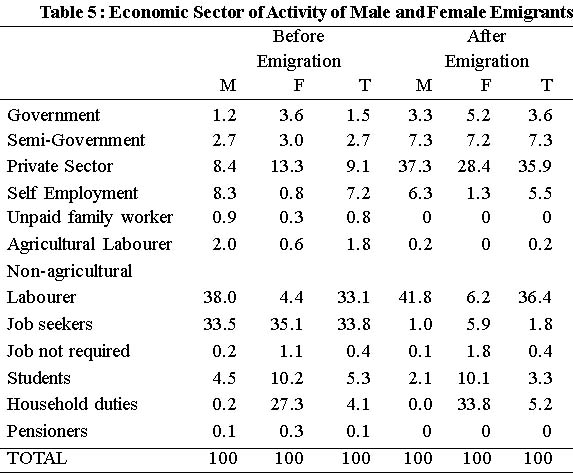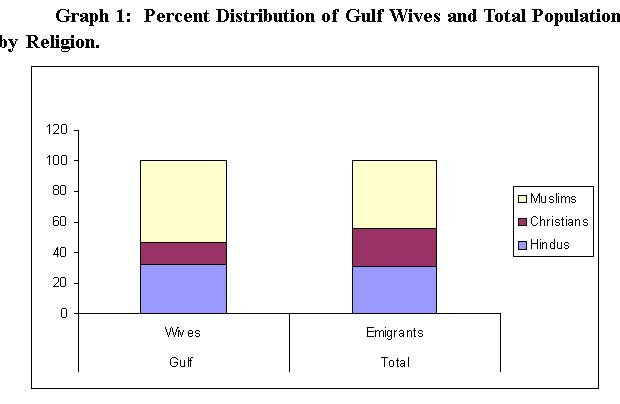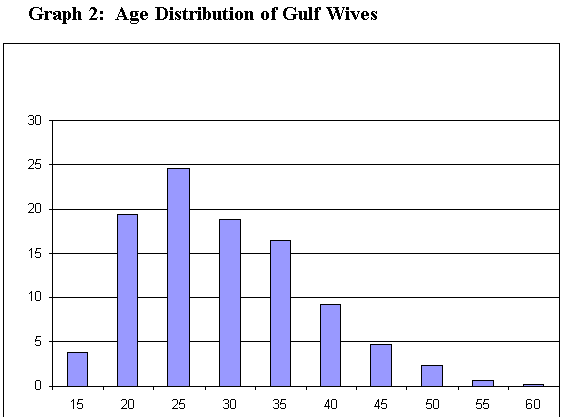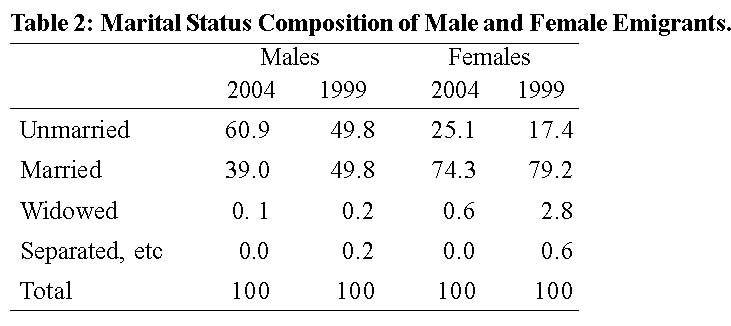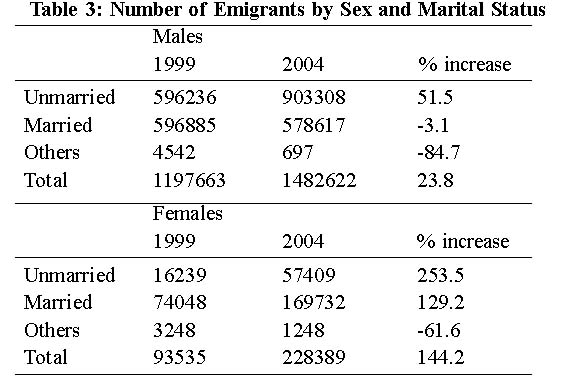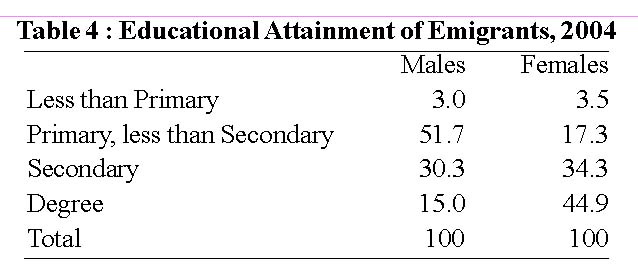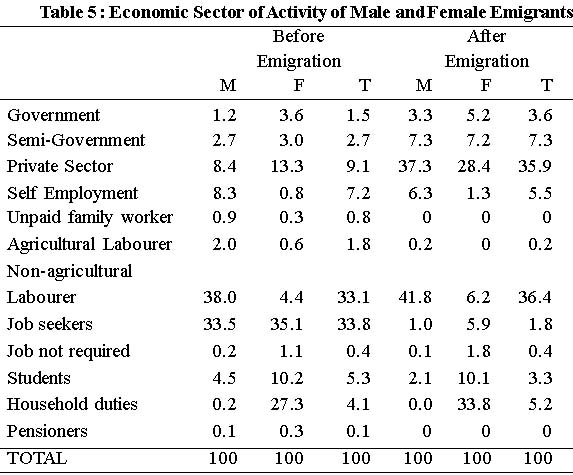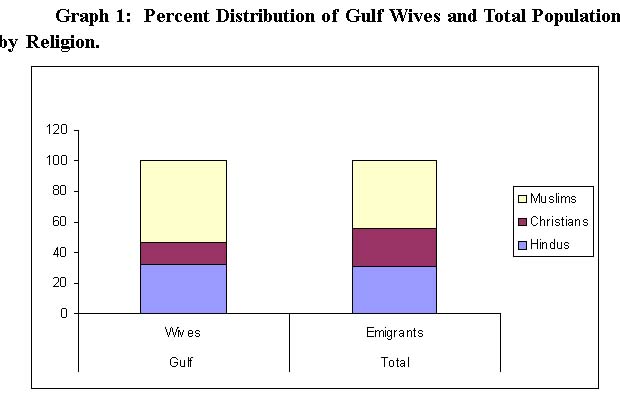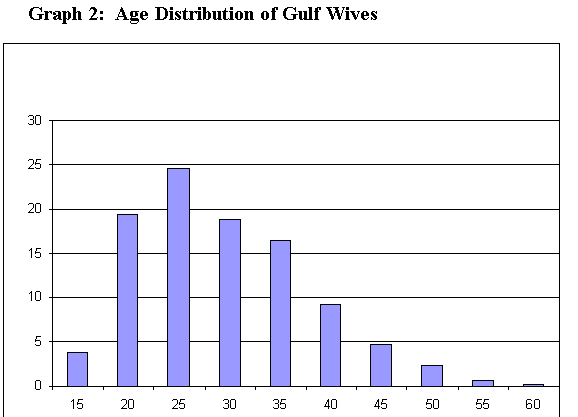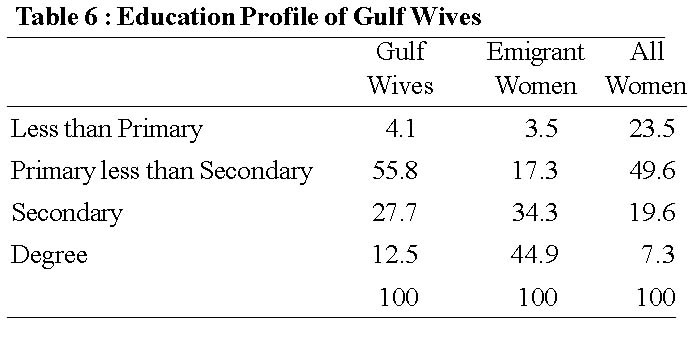|
Abstract : Female emigration is very culture specific and it is not very common in Kerala. This paper attempts to put together the information collected on female emigration from Kerala in two recent studies. During 1999-2004, the percent increase in emigration was 124 percent among females but just 24 percent among males. The proportion of female emigrants varies considerably by religion and by district of origin. Christian emigrants include the largest proportion of women, 32 percent, while Muslim emigrants recorded the lowest proportion of women, just 8 percent. About 45 percent of the female emigrants were degree holders. If current trends in ageing continue as predicted, the proportions of the young and the old will undergo a historic crossover around 2021. Keywords: Female emigration, Kerala Migration Study, non-resident Keralites, emigration and religion, emigration and education, Marital Status of emigrants, Gulf wives Emigration from Kerala is essentially a male prerogative. Few females emigrate alone; if they do so, they emigrate as wives or relatives of male emigrants. On the other hand, in Sri Lanka, across the Gulf of Mannar, the situation is just the opposite. While only 17 percent of the emigrants from Kerala were females, as much as 70 percent of the emigrants from Sri Lanka were females. Female emigration is very culture specific; it is very common in some cultures but not so common in some others. It is not very common in Kerala, at least not yet. Information on female emigration from Kerala is relatively rare. This paper attempts to put together the information we have collected on female emigration from Kerala in two recent studies. The first one was in 1999 (Kerala Migration Study or KMS) and the second one was in 2004 (South Asia Migration Study or SMS). A brief account about these studies and what they have concluded with respect to emigration and its impact on Kerala society in general is in order. The KMS was conducted in 1998/99 using data collected from a sample of 10,000 households selected at random from all the districts and taluks in the state. It was a mammoth effort covering most social and economic aspects of emigration that was of concern to planners and policy makers. That study has now become a sort of classic, the most authoritative source of factual and analytical information on Gulf migration from Kerala. The KMS concluded thus: Migration has provided the single most dynamic factor in the otherwise dismal scenario of Kerala in the last quarter of the twentieth century. It is one of the positive outcomes of the Kerala Model of Development. Kerala is approaching the end of the millennium with a little cheer in many of its homes, thanks to migration and the economic returns that it brings. In Kerala, migration must have contributed more to poverty alleviation than any other factor including agrarian reforms, trade union activities and social welfare legislation (Zachariah, Mathew and Irudaya Rajan, May 2000, CDS Working Paper No. 303) The SMS was conducted 5 years later in 2003/04 using data from a sample 10,000 households selected the same way as the KMS sample of 10,000 households was selected. One difference, however, was that the SMS sample of 10,000 households included about 5000 households which were canvassed in 1998/99. Thus SMS has data from the same set of 5000 households at an interval of 5 years. Before we come to a discussion of the part played by women in Kerala’s emigration episode, we give below some information of emigrants from Kerala in general, males and females. A discussion of female emigration cannot be isolated from a discussion of male emigration. Comparisons add considerable depth to the analysis. According to SMS the number of emigrants from Kerala in 2004 was 18.4 lakh persons, roughly 27 emigrants per 100 households. The comparable figure in 1999 (KMS) was 13.6 lakh persons, roughly 21 emigrants per 100 households. There was thus a relatively large increase, about 35 percent, in the number of emigrants from Kerala during the five-year period 1999-2004. The number of return emigrants was 8.9 lakh persons in 2004 as against 7.4 lakh persons in 1999. They represented 13.0 persons per 100 households in 2004 and 11.6 persons per 100 households in 1999. The return emigration showed a slower rate of growth, about 21 percent in the 5-year period. The number of non-resident Keralites (NRKs), defined as the sum of emigrants and return emigrants was 27.3 lakh in 2004 and 21.0 lakh in 1999 indicating an increase of 30 percent during 1999-2004. There were about 40 NRKs per 100 households in 2004 but only 33 in 1999. The number of NRKs per 100 households has increased by 7 persons during the period. One important point to note about these numbers is that, although there were 40 NRKs per 100 households in 2004, only about 26 of them had an NRK; 74 percent did not. Several households have more than one NRK. The proportion of households with at least one emigrant or one return emigrant (NRK > 0) was 24 percent in 1999 as against 26 percent in 2004. There was thus a slight increase in the spread of emigration among the households in Kerala. At the same time, the total number of households without an NRK has actually increased by about 2.7 lakh during the 5-year period. It was 4.8 lakh in 1999 and 5.1 lakh in 2004. In the past 5 years, Kerala emigrants have spread their wings over a much wider spectrum of countries in the world: North America, Europe and South East Asia. Within the Gulf region itself there were some significant realignments, some countries gaining ground at the expense of others. Within Kerala there were signs of realignment as far as the district of origin is concerned, some districts gaining ground, at the expense of some traditionally important districts of emigration. In 1999, about 95 percent of Kerala emigrants went to the Gulf countries; and the other 5 percent went mainly to the USA and Africa. By 2004, the share of the Kerala emigrants in the Gulf has declined to about 90 percent and that in countries other than the Gulf has increased to 10 percent. The principal destinations of Kerala emigrants outside the Gulf were the USA, England, Singapore, and Maldives Islands. Within the Gulf region, the principal destinations were the UAE, and Saudi Arabia, which together accounted for more than two-thirds of all emigrants in the Gulf. In 2004 the share of the UAEhas increased to 36.5 percent, up from 31.0 percent in 1999. On the contrary, the share of Saudi Arabia declined to 26.7 percent from 37.5 percent in 1999. There was thus a significant realignment between these countries in recent years. Along with the change in the destinations, there were also changes in the relative importance of districts as the place of origin of Kerala emigrants. Although Malappuram district continued to send out the largest number of emigrants, it had lost some ground to other northern districts. Between 1999 and 2004 there was a slight northward shift in the centre of location of emigrants from Kerala. The principal destinations of emigrants from Kerala were Muslim countries. A natural consequence of it was that, the majority of the emigrants were also Muslims. Among the emigrants, the proportion of the Muslims was 43.7 percent in 2004 and 41.9 in 1999. Their share in the sample population was only 25.9 percent in 2004 and 27.1 percent in 1999. Hindus constituted 31.2 percent of the total number of emigrants and Christians 25.1 percent. Over the 5-year period while Muslims have increased their share, Hindus have decreased their share. For every 100 households there were 82 NRKs among Muslims, but only 22 among the Hindus. Muslims also stand apart with respect to the proportion of households with an NRK. Among them one in two households has an NRK. This is also true of Mar Thoma Syrian Christians. Among the scheduled castes only less than 5 percent of the households have an NRK. Female Emigration from Kerala In earlier years, emigrants from Kerala were mainly construction workers in the Gulf countries living in worker camps where family accommodation was not provided. But in recent years, more and more of the emigrants are withhigher level of education who can afford renting apartments and bringing their families. The proportion of female emigrants does vary considerably by religion and by district of origin. Christian emigrants include the largest proportion of women, 32 percent, while Muslim emigrants recorded the lowest proportion of women, just 8 percent.
The relation between religion and sex composition of emigrants is reflected in the inter-district variation of the sex composition of emigrants. The largest proportion of female emigrants was among those who originated from Kottayam district, 47.3 percent, about 30 percentage points more than the state average of about 17 percent. The other districts with high proportion of female emigrants were Ernakulam and Pathanamthitta. More than half the number of emigrants were unmarried. Emigration of the unmarried was particularly large among the males, sixty percent. Among females, however, nearly three-fourths were married, only 25 percent were unmarried. Between 1999 and 2004 the proportion of the unmarried increased among males as well as among females and correspondingly the proportion of the married decreased.
The number of unmarried emigrants increased considerably during 1999-04, by 51 percent among males and 254 percent among females. This large increase in the number of unmarried women leaving Kerala to foreign countries is a relatively new phenomenon and the trend portends acceleration in the emigration of young unmarried women from Kerala in the coming years. An equally important trend is the decline in the number of married men at a time when the total number of emigrants had increased by 33 percent. Educational Attainment
Employment Status
|
|
|
Before emigration about 35 percent of women emigrants were unemployed. They were in search of a job. Another 27 percent, emigrants continued to remain in household duties. Among others, most became employed in either private sector (28 percent) or as labourers in non-agriculture sector (6 percent). Thus, the shift from being job seekers to either employed in private sector or Government or Semi-government services is the most important change in employment of females brought about by emigration. Unemployment rate is very high among females in Kerala in general and among female emigrants in particular before emigration. Among female emigrants unemployment rate was as high as 57 percent before emigration. But at destination, the rate was only 11 percent. Thus emigration helped many women to move out of the unemployed category to the employed category.
Economic Activity of Degree – holding Female emigrants
About 45 percent of the female emigrants were degree holders. The study indicated that about 43 percent of the degree holding emigrants were unemployed before emigration. About 25 percent were engaged in household duties. Altogether about a third of the total were not in the labour force at all. About 11 percent were working in private sector and about 10 percent in Government or semi Government organisations. The unemployment rate (unemployed per 100 in the labour force) was about 66 percent.
After emigration the proportion of unemployed decreased considerably to 10 percent, the proportion in household duties increased considerably to 35 percent (from 25 percent before emigration). The proportion working in Government, (from 4.8 to 7.8 percent) semi Government (from 4.8 percent to 11.4 percent) and in private sector (from 10.8 to 24.7 percent) also increased greatly. The unemployment rate plummeted from 65.7 percent before emigration to 17.5 percent after emigration.
Gulf Wives
The total number of married men among the emigrants (at destination) exceeded the total number of married women by 408,885. This means that, at least 409,000 married men are living abroad without their wives with them. The number could be much larger.
In SMS we tried to get an estimate of the number of wives who live in Kerala without their husbands, that is, married women separated from their husbands as a result of emigration. In the 10,000 households we surveyed, there were 1,534 married women who reported that their husbands lived outside India. This shows that about 15.6 percent of the households have married women whose husbands are away. Applying to all 688,000 households in Kerala, we get an estimate of about 1.05 million wives who live without their husbands. The corresponding number in 1999 was one million. Thus the increase in the incidence of separation of wives from husbands did not correspond to the increase emigrants. More and more emigrants are taking their wives to their country of residence. Still the number is large, about a million. Much more progress is needed in this matter.
|
|
|
|
Graph 1 gives the variation in the proportion of Gulf wives by religion. While 45 percent of the emigrants belonged to the Muslim community as much as 54 percent of the Gulf wives in Kerala were of this community. On the other hand about 25 percent of the emigrants were Christians but only 14 percent of the Gulf wives belonged to this religious group. Incidence of separation of wives from husband is not as common among Christians as among Muslims.
As graph 2 indicates, some of the gulf wives are very young, some below age 20. They could have been separated just after their marriage. The vast majority of them are in the 25-29 age group. The social and psychological impacts of male migration on women left behind are largely unknown.
Education of Gulf Wives
Gulf wives are not as much educated as the female emigrants are, but they are more educated than the Kerala women in general. Only 12.5 percent of Gulf wives have a degree as opposed to 45 percent among emigrant women.
|
|
Economic Activity
Very few of the Gulf wives were gainfully employed. About 8 percent of them were gainfully employed, but as much as 79 percent were outside the labour force. About 13 percent were unemployed. The unemployment rate as a percent of the labour force was as much as 63 percent.
|
|
Future Prospects for Female emigration
On the whole, conditions in Kerala are favourable for an increasing trend in female emigration. First of all, in the Gulf region, which is the principal destination of Kerala emigration, the construction phase of its reconstruction is largely over. The demand for unskilled construction workers is likely to decrease further. The future is for the emigration of the educated skilled persons. Being well educated, even better educated than their male counterparts, Kerala women can compete well not only with men from Kerala but also those from most other developing countries. Many of the future job opportunities in the Gulf and elsewhere in the world are well suited to the qualifications of Kerala women. There might be an increased trend in female emigration. The recent opening up of higher education to private sector and opening up self-financing educational institutions will give a fillip to female emigration from the state.
Between 1999 and 2004 female emigration has already increased by 144 percent. Female emigration from Kerala has a lot more horsepower left which will manifest itself in the coming years.
REFERENCES
Zachariah, K. C and S. Irudaya Rajan. (2004a), Gulf Revisited. Economic Consequences of Emigration from Kerala – Emigration and Unemployment, Centre for Development Studies, Thiruvananthapuram.
Zachariah, K.C and S. Irudaya Rajan. (2004b), ‘Malayali Emigration Moving in to a Higher Orbit,’ Passline, 8.7.
Zachariah, K.C, E. T Mathew and S. Irudaya Rajan. (2003), ‘Dynamics of Migration in Kerala. Dimensions, Determinants and Consequences,’ Orient Longman, Hyderabad.
Zachariah, K. C, K. P Kannan and S. Irudaya Rajan. (2002), ‘Kerala’s Gulf Connection: CDS Studies on International Labour Migration from Kerala State in India,’ Centre for Development Studies, Thiruvananthapuram. Monograph Series.
Zachariah, K.C , B. A Prakash and S. Irudaya Rajan (2003), ‘The Impact of Immigration Policy on Indian Contract Migrants: The Case of the United Arab Emirates,’ International Migration, 41. 4 : 161-172.
Zachariah, K.C, E.T Mathew and S. Irudaya Rajan. (2001a) ‘Impact of Migration on Kerala’s Economy and Society,’ International Migration, 39. 1 : 63-88 (first published as a CDS working paper No. 297. www.cds.edu).
Zachariah, K.C, E.T Mathew and S. Irudaya Rajan. (2001b), ‘Social, Economic and Demographic Consequences of Migration on Kerala,’ International Migration, 39. 2 : 43-71. 88 (first published as a CDS working paper No. 303. www.cds.edu).
Zachariah, K. C and S. Irudaya Rajan. (2001a), ‘Gender Dimensions of Migration in Kerala: Macro and Micro Evidence,’ Asia Pacific Population Journal, 16. 3 : 47-70
Zachariah, K. C, B. A Praksah and S. Irudaya Rajan. (2004), ‘Indian Workers in UAE: Employment, Wages and Working Conditions’ Economic and Political Weekly, XXXIX. 22: 2227-2234.
Zachariah, K. C and S. Irudaya Rajan. (2001b), ‘Migration Mosaic in Kerala. Trends and Determinants,’ Demography India, 30. 1: 137-165.
Zachariah, K.C, B.A Prakash and S. Irudaya Rajan. (2002) ‘Gulf Migration Study: Employment Wages and Working Conditions of Kerala Emigrants in United Arab Emirates,’ Centre for Development Studies (Thiruvananthapuram) Working Paper No.326. www.cds.edu
IRUDAYARAJAN. S. Is Associate Fellow at the Centre for Development Studies (CDS), Thiruvananthapuram. He is a lead author of the book, India’s Elderly: Burden or Challenge? An Aging India: Perspectives, Prospects and Policies, is edited by Irudaya Rajan and Phoebe Liebig of Andrus Gerontology Centre, University of Southern California, Los Angeles. He has co-authored/co-edited several books and articles in national and international journals. Currently, he is coordinating two major projects – Care of the Elderly and Healthy Ageing.
ZACHARIAH, K C. Is Honorary Fellow at the Centre for Development Studies, Thiruvananthapuram. He is a lead author of the book, Dynamics of Migration in Kerala: Dimensions, Differentials and Consequences published by Orient Longman Private Limited, Hyderabad. Zachariah and S Irudaya Rajan have produced several important books/monographs on Kerala’s Demography – Demographic Transition in Kerala in the 1980s, Kerala’s Demographic Transition, Dynamics of Migration in Kerala, Return Emigrants in Kerala and Gulf Revisited and conducted two major migration surveys on Kerala.
|
GULF EMIGRATION OF WOMEN IN KERALA K.C.ZACHARIAH & S.IRUDAYA RAJAN |
|||||||||
|
Abstract : Female emigration is very culture specific and it is not very common in Kerala. This paper attempts to put together the information collected on female emigration from Kerala in two recent studies. During 1999-2004, the percent increase in emigration was 124 percent among females but just 24 percent among males. The proportion of female emigrants varies considerably by religion and by district of origin. Christian emigrants include the largest proportion of women, 32 percent, while Muslim emigrants recorded the lowest proportion of women, just 8 percent. About 45 percent of the female emigrants were degree holders. If current trends in ageing continue as predicted, the proportions of the young and the old will undergo a historic crossover around 2021. Keywords: Female emigration, Kerala Migration Study, non-resident Keralites, emigration and religion, emigration and education, Marital Status of emigrants, Gulf wives Emigration from Kerala is essentially a male prerogative. Few females emigrate alone; if they do so, they emigrate as wives or relatives of male emigrants. On the other hand, in Sri Lanka, across the Gulf of Mannar, the situation is just the opposite. While only 17 percent of the emigrants from Kerala were females, as much as 70 percent of the emigrants from Sri Lanka were females. Female emigration is very culture specific; it is very common in some cultures but not so common in some others. It is not very common in Kerala, at least not yet. Information on female emigration from Kerala is relatively rare. This paper attempts to put together the information we have collected on female emigration from Kerala in two recent studies. The first one was in 1999 (Kerala Migration Study or KMS) and the second one was in 2004 (South Asia Migration Study or SMS). A brief account about these studies and what they have concluded with respect to emigration and its impact on Kerala society in general is in order. The KMS was conducted in 1998/99 using data collected from a sample of 10,000 households selected at random from all the districts and taluks in the state. It was a mammoth effort covering most social and economic aspects of emigration that was of concern to planners and policy makers. That study has now become a sort of classic, the most authoritative source of factual and analytical information on Gulf migration from Kerala. The KMS concluded thus: Migration has provided the single most dynamic factor in the otherwise dismal scenario of Kerala in the last quarter of the twentieth century. It is one of the positive outcomes of the Kerala Model of Development. Kerala is approaching the end of the millennium with a little cheer in many of its homes, thanks to migration and the economic returns that it brings. In Kerala, migration must have contributed more to poverty alleviation than any other factor including agrarian reforms, trade union activities and social welfare legislation (Zachariah, Mathew and Irudaya Rajan, May 2000, CDS Working Paper No. 303) The SMS was conducted 5 years later in 2003/04 using data from a sample 10,000 households selected the same way as the KMS sample of 10,000 households was selected. One difference, however, was that the SMS sample of 10,000 households included about 5000 households which were canvassed in 1998/99. Thus SMS has data from the same set of 5000 households at an interval of 5 years. Before we come to a discussion of the part played by women in Kerala’s emigration episode, we give below some information of emigrants from Kerala in general, males and females. A discussion of female emigration cannot be isolated from a discussion of male emigration. Comparisons add considerable depth to the analysis. According to SMS the number of emigrants from Kerala in 2004 was 18.4 lakh persons, roughly 27 emigrants per 100 households. The comparable figure in 1999 (KMS) was 13.6 lakh persons, roughly 21 emigrants per 100 households. There was thus a relatively large increase, about 35 percent, in the number of emigrants from Kerala during the five-year period 1999-2004. The number of return emigrants was 8.9 lakh persons in 2004 as against 7.4 lakh persons in 1999. They represented 13.0 persons per 100 households in 2004 and 11.6 persons per 100 households in 1999. The return emigration showed a slower rate of growth, about 21 percent in the 5-year period. The number of non-resident Keralites (NRKs), defined as the sum of emigrants and return emigrants was 27.3 lakh in 2004 and 21.0 lakh in 1999 indicating an increase of 30 percent during 1999-2004. There were about 40 NRKs per 100 households in 2004 but only 33 in 1999. The number of NRKs per 100 households has increased by 7 persons during the period. One important point to note about these numbers is that, although there were 40 NRKs per 100 households in 2004, only about 26 of them had an NRK; 74 percent did not. Several households have more than one NRK. The proportion of households with at least one emigrant or one return emigrant (NRK > 0) was 24 percent in 1999 as against 26 percent in 2004. There was thus a slight increase in the spread of emigration among the households in Kerala. At the same time, the total number of households without an NRK has actually increased by about 2.7 lakh during the 5-year period. It was 4.8 lakh in 1999 and 5.1 lakh in 2004. In the past 5 years, Kerala emigrants have spread their wings over a much wider spectrum of countries in the world: North America, Europe and South East Asia. Within the Gulf region itself there were some significant realignments, some countries gaining ground at the expense of others. Within Kerala there were signs of realignment as far as the district of origin is concerned, some districts gaining ground, at the expense of some traditionally important districts of emigration. In 1999, about 95 percent of Kerala emigrants went to the Gulf countries; and the other 5 percent went mainly to the USA and Africa. By 2004, the share of the Kerala emigrants in the Gulf has declined to about 90 percent and that in countries other than the Gulf has increased to 10 percent. The principal destinations of Kerala emigrants outside the Gulf were the USA, England, Singapore, and Maldives Islands. Within the Gulf region, the principal destinations were the UAE, and Saudi Arabia, which together accounted for more than two-thirds of all emigrants in the Gulf. In 2004 the share of the UAEhas increased to 36.5 percent, up from 31.0 percent in 1999. On the contrary, the share of Saudi Arabia declined to 26.7 percent from 37.5 percent in 1999. There was thus a significant realignment between these countries in recent years. Along with the change in the destinations, there were also changes in the relative importance of districts as the place of origin of Kerala emigrants. Although Malappuram district continued to send out the largest number of emigrants, it had lost some ground to other northern districts. Between 1999 and 2004 there was a slight northward shift in the centre of location of emigrants from Kerala. The principal destinations of emigrants from Kerala were Muslim countries. A natural consequence of it was that, the majority of the emigrants were also Muslims. Among the emigrants, the proportion of the Muslims was 43.7 percent in 2004 and 41.9 in 1999. Their share in the sample population was only 25.9 percent in 2004 and 27.1 percent in 1999. Hindus constituted 31.2 percent of the total number of emigrants and Christians 25.1 percent. Over the 5-year period while Muslims have increased their share, Hindus have decreased their share. For every 100 households there were 82 NRKs among Muslims, but only 22 among the Hindus. Muslims also stand apart with respect to the proportion of households with an NRK. Among them one in two households has an NRK. This is also true of Mar Thoma Syrian Christians. Among the scheduled castes only less than 5 percent of the households have an NRK. Female Emigration from Kerala In earlier years, emigrants from Kerala were mainly construction workers in the Gulf countries living in worker camps where family accommodation was not provided. But in recent years, more and more of the emigrants are withhigher level of education who can afford renting apartments and bringing their families. The proportion of female emigrants does vary considerably by religion and by district of origin. Christian emigrants include the largest proportion of women, 32 percent, while Muslim emigrants recorded the lowest proportion of women, just 8 percent.
The relation between religion and sex composition of emigrants is reflected in the inter-district variation of the sex composition of emigrants. The largest proportion of female emigrants was among those who originated from Kottayam district, 47.3 percent, about 30 percentage points more than the state average of about 17 percent. The other districts with high proportion of female emigrants were Ernakulam and Pathanamthitta. More than half the number of emigrants were unmarried. Emigration of the unmarried was particularly large among the males, sixty percent. Among females, however, nearly three-fourths were married, only 25 percent were unmarried. Between 1999 and 2004 the proportion of the unmarried increased among males as well as among females and correspondingly the proportion of the married decreased.
The number of unmarried emigrants increased considerably during 1999-04, by 51 percent among males and 254 percent among females. This large increase in the number of unmarried women leaving Kerala to foreign countries is a relatively new phenomenon and the trend portends acceleration in the emigration of young unmarried women from Kerala in the coming years. An equally important trend is the decline in the number of married men at a time when the total number of emigrants had increased by 33 percent. Educational Attainment
Employment Status
|
|
|
Before emigration about 35 percent of women emigrants were unemployed. They were in search of a job. Another 27 percent, emigrants continued to remain in household duties. Among others, most became employed in either private sector (28 percent) or as labourers in non-agriculture sector (6 percent). Thus, the shift from being job seekers to either employed in private sector or Government or Semi-government services is the most important change in employment of females brought about by emigration. Unemployment rate is very high among females in Kerala in general and among female emigrants in particular before emigration. Among female emigrants unemployment rate was as high as 57 percent before emigration. But at destination, the rate was only 11 percent. Thus emigration helped many women to move out of the unemployed category to the employed category.
Economic Activity of Degree – holding Female emigrants
About 45 percent of the female emigrants were degree holders. The study indicated that about 43 percent of the degree holding emigrants were unemployed before emigration. About 25 percent were engaged in household duties. Altogether about a third of the total were not in the labour force at all. About 11 percent were working in private sector and about 10 percent in Government or semi Government organisations. The unemployment rate (unemployed per 100 in the labour force) was about 66 percent.
After emigration the proportion of unemployed decreased considerably to 10 percent, the proportion in household duties increased considerably to 35 percent (from 25 percent before emigration). The proportion working in Government, (from 4.8 to 7.8 percent) semi Government (from 4.8 percent to 11.4 percent) and in private sector (from 10.8 to 24.7 percent) also increased greatly. The unemployment rate plummeted from 65.7 percent before emigration to 17.5 percent after emigration.
Gulf Wives
The total number of married men among the emigrants (at destination) exceeded the total number of married women by 408,885. This means that, at least 409,000 married men are living abroad without their wives with them. The number could be much larger.
In SMS we tried to get an estimate of the number of wives who live in Kerala without their husbands, that is, married women separated from their husbands as a result of emigration. In the 10,000 households we surveyed, there were 1,534 married women who reported that their husbands lived outside India. This shows that about 15.6 percent of the households have married women whose husbands are away. Applying to all 688,000 households in Kerala, we get an estimate of about 1.05 million wives who live without their husbands. The corresponding number in 1999 was one million. Thus the increase in the incidence of separation of wives from husbands did not correspond to the increase emigrants. More and more emigrants are taking their wives to their country of residence. Still the number is large, about a million. Much more progress is needed in this matter.
|
|
|
|
Graph 1 gives the variation in the proportion of Gulf wives by religion. While 45 percent of the emigrants belonged to the Muslim community as much as 54 percent of the Gulf wives in Kerala were of this community. On the other hand about 25 percent of the emigrants were Christians but only 14 percent of the Gulf wives belonged to this religious group. Incidence of separation of wives from husband is not as common among Christians as among Muslims.
As graph 2 indicates, some of the gulf wives are very young, some below age 20. They could have been separated just after their marriage. The vast majority of them are in the 25-29 age group. The social and psychological impacts of male migration on women left behind are largely unknown.
Education of Gulf Wives
Gulf wives are not as much educated as the female emigrants are, but they are more educated than the Kerala women in general. Only 12.5 percent of Gulf wives have a degree as opposed to 45 percent among emigrant women.
|
|
Economic Activity
Very few of the Gulf wives were gainfully employed. About 8 percent of them were gainfully employed, but as much as 79 percent were outside the labour force. About 13 percent were unemployed. The unemployment rate as a percent of the labour force was as much as 63 percent.
|
|
Future Prospects for Female emigration
On the whole, conditions in Kerala are favourable for an increasing trend in female emigration. First of all, in the Gulf region, which is the principal destination of Kerala emigration, the construction phase of its reconstruction is largely over. The demand for unskilled construction workers is likely to decrease further. The future is for the emigration of the educated skilled persons. Being well educated, even better educated than their male counterparts, Kerala women can compete well not only with men from Kerala but also those from most other developing countries. Many of the future job opportunities in the Gulf and elsewhere in the world are well suited to the qualifications of Kerala women. There might be an increased trend in female emigration. The recent opening up of higher education to private sector and opening up self-financing educational institutions will give a fillip to female emigration from the state.
Between 1999 and 2004 female emigration has already increased by 144 percent. Female emigration from Kerala has a lot more horsepower left which will manifest itself in the coming years.
REFERENCES
Zachariah, K. C and S. Irudaya Rajan. (2004a), Gulf Revisited. Economic Consequences of Emigration from Kerala – Emigration and Unemployment, Centre for Development Studies, Thiruvananthapuram.
Zachariah, K.C and S. Irudaya Rajan. (2004b), ‘Malayali Emigration Moving in to a Higher Orbit,’ Passline, 8.7.
Zachariah, K.C, E. T Mathew and S. Irudaya Rajan. (2003), ‘Dynamics of Migration in Kerala. Dimensions, Determinants and Consequences,’ Orient Longman, Hyderabad.
Zachariah, K. C, K. P Kannan and S. Irudaya Rajan. (2002), ‘Kerala’s Gulf Connection: CDS Studies on International Labour Migration from Kerala State in India,’ Centre for Development Studies, Thiruvananthapuram. Monograph Series.
Zachariah, K.C , B. A Prakash and S. Irudaya Rajan (2003), ‘The Impact of Immigration Policy on Indian Contract Migrants: The Case of the United Arab Emirates,’ International Migration, 41. 4 : 161-172.
Zachariah, K.C, E.T Mathew and S. Irudaya Rajan. (2001a) ‘Impact of Migration on Kerala’s Economy and Society,’ International Migration, 39. 1 : 63-88 (first published as a CDS working paper No. 297. www.cds.edu).
Zachariah, K.C, E.T Mathew and S. Irudaya Rajan. (2001b), ‘Social, Economic and Demographic Consequences of Migration on Kerala,’ International Migration, 39. 2 : 43-71. 88 (first published as a CDS working paper No. 303. www.cds.edu).
Zachariah, K. C and S. Irudaya Rajan. (2001a), ‘Gender Dimensions of Migration in Kerala: Macro and Micro Evidence,’ Asia Pacific Population Journal, 16. 3 : 47-70
Zachariah, K. C, B. A Praksah and S. Irudaya Rajan. (2004), ‘Indian Workers in UAE: Employment, Wages and Working Conditions’ Economic and Political Weekly, XXXIX. 22: 2227-2234.
Zachariah, K. C and S. Irudaya Rajan. (2001b), ‘Migration Mosaic in Kerala. Trends and Determinants,’ Demography India, 30. 1: 137-165.
Zachariah, K.C, B.A Prakash and S. Irudaya Rajan. (2002) ‘Gulf Migration Study: Employment Wages and Working Conditions of Kerala Emigrants in United Arab Emirates,’ Centre for Development Studies (Thiruvananthapuram) Working Paper No.326. www.cds.edu
IRUDAYARAJAN. S. Is Associate Fellow at the Centre for Development Studies (CDS), Thiruvananthapuram. He is a lead author of the book, India’s Elderly: Burden or Challenge? An Aging India: Perspectives, Prospects and Policies, is edited by Irudaya Rajan and Phoebe Liebig of Andrus Gerontology Centre, University of Southern California, Los Angeles. He has co-authored/co-edited several books and articles in national and international journals. Currently, he is coordinating two major projects – Care of the Elderly and Healthy Ageing.
ZACHARIAH, K C. Is Honorary Fellow at the Centre for Development Studies, Thiruvananthapuram. He is a lead author of the book, Dynamics of Migration in Kerala: Dimensions, Differentials and Consequences published by Orient Longman Private Limited, Hyderabad. Zachariah and S Irudaya Rajan have produced several important books/monographs on Kerala’s Demography – Demographic Transition in Kerala in the 1980s, Kerala’s Demographic Transition, Dynamics of Migration in Kerala, Return Emigrants in Kerala and Gulf Revisited and conducted two major migration surveys on Kerala.


